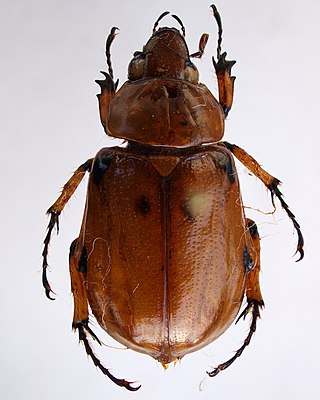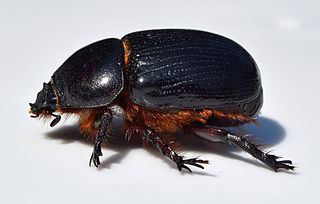
Dynastinae or rhinoceros beetles are a subfamily of the scarab beetle family (Scarabaeidae). Other common names – some for particular groups of rhinoceros beetles – include Hercules beetles, unicorn beetles or horn beetles. Over 1,500 species and 225 genera of rhinoceros beetles are known.

Chrysina, or jewel scarabs, is a genus of brightly colored, often metallic iridescent species of ruteline beetles. They range from the southwestern edge of the United States, through Mexico and Central America, and as far south as Colombia and Ecuador. Chrysina contains more than 120 species, includes all those formerly in the genus Plusiotis. The genus name is from Greek χρύσινος (chrysinos), "gold-coloured".

Flower chafers are a group of scarab beetles comprising the subfamily Cetoniinae. Many species are diurnal and visit flowers for pollen and nectar, or to browse on the petals. Some species also feed on fruit. The group is also called fruit and flower chafers, flower beetles and flower scarabs. There are around 4,000 species, many of them still undescribed.

Melolonthinae is a subfamily of the scarab beetles. It is a very diverse group; distributed over most of the world, it contains over 11,000 species in over 750 genera. Some authors include the scarab subfamilies Euchirinae and Pachypodinae as tribes in the Melolonthinae.

Tomarus is a genus of scarab beetles in the subfamily Dynastinae, the rhinoceros beetles. They are native to the Americas, where they are distributed from the central United States to Argentina, and a few species occur in the Caribbean.

Oryctes is the economically most important genus of rhinoceros beetles in the subfamily Dynastinae and includes serious pests of palm trees. A total of 47 species have been assigned to the genus, including 2 fossil ones. The extant species are widely distributed in Africa, as well as in Europe, Asia and the Pacific. No established populations are known from the Americas. The species are typically between 30 and 60 mm long, dark brown to black, with a robust body and a strong cuticle. They can be distinguished from other genera in the tribe Oryctini by the structure of the pronotum, the horn on the head, the mouthparts and other features.

Pelidnota is a genus of beetles of the family Scarabaeidae. There are more than 180 described species in Pelidnota, found in the Neotropics.

Pentodontini is a tribe of rhinoceros beetles in the family Scarabaeidae. There are over 100 genera in the tribe Pentodontini.
Hemiphileurus is a genus of rhinoceros beetles in the family Scarabaeidae. There are at least 60 described species in Hemiphileurus.

Ancognatha is a genus of rhinoceros beetles in the family Scarabaeidae. There are more than 20 described species in Ancognatha.

Phileurus is a genus of rhinoceros beetles in the family Scarabaeidae. There are more than 20 described species in Phileurus.

Xyloryctes is a genus of rhinoceros beetles in the family Scarabaeidae. There are about 13 described species in Xyloryctes.

Dyscinetus is a genus of rice beetles in the family Scarabaeidae. There are more than 20 described species in Dyscinetus.

Archophileurus is a genus of rhinoceros beetles in the family Scarabaeidae. There are at least 30 described species in Archophileurus.

Oryctini is a tribe of beetles in the Dynastinae.

Heteronychus is a genus of beetles belonging to the family Scarabaeidae, subfamily Dynastinae.

The Phileurini are a tribe of beetles in the subfamily Dynastinae.















